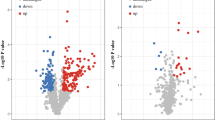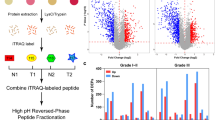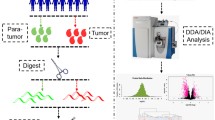Abstract
Mitochondria are key organelles in mammary cells responsible for several cellular functions including growth, division, and energy metabolism. In this study, mitochondrial proteins were enriched for proteomics analysis with the state-of-the-art two-dimensional differential gel electrophoresis and matrix-assistant laser desorption ionization–time-of-flight mass spectrometry strategy to compare and identify the mitochondrial protein profiling changes between three breast cell lines with different tumorigenicity and metastasis. The proteomics results demonstrate more than 1,500 protein features were resolved from the equal amount pooled from three purified mitochondrial proteins, and 125 differentially expressed spots were identified by their peptide finger print, in which, 33 identified proteins belonged to mitochondrial proteins. Eighteen out of these 33 identified mitochondrial proteins such as SCaMC-1 have not been reported in breast cancer research to our knowledge. Additionally, mitochondrial protein prohibitin has shown to be differentially distributed in mitochondria and in nucleus for normal breast cells and breast cancer cell lines, respectively. To sum up, our approach to identify the mitochondrial proteins in various stages of breast cancer progression and the identified proteins may be further evaluated as potential breast cancer markers in prognosis and therapy.








Similar content being viewed by others
Abbreviations
- 1-DE:
-
One-dimensional gel electrophoresis
- 2-DE:
-
Two-dimensional gel electrophoresis
- Ab:
-
Antibody
- CCB:
-
Colloidal Coomassie blue
- CHAPS:
-
3-[(3-Cholamidopropyl)-dimethylammonio]-1-propanesulfonate)
- ddH2O:
-
Double deionized water
- DIGE:
-
Differential gel electrophoresis
- DTT:
-
Dithiothreitol
- FCS:
-
Fetal calf serum
- MALDI-TOF MS:
-
Matrix-assisted laser desorption ionization–time-of-flight mass spectrometry
- NP-40:
-
Nonidet P-40
- TFA:
-
Trifluoroacetic acid
References
Artal-Sanz M, Tavernarakis N (2009) Prohibitin and mitochondrial biology. Trends Endocrinol Metab 20:394–401
Chan HL, Gaffney PR, Waterfield MD, Anderle H, Peter MH, Schwarz HP, Turecek PL, Timms JF (2006) Proteomic analysis of UVC irradiation-induced damage of plasma proteins: serum amyloid P component as a major target of photolysis. FEBS Lett 580:3229–3236
Chan HL, Gharbi S, Gaffney PR, Cramer R, Waterfield MD, Timms JF (2005) Proteomic analysis of redox- and ErbB2-dependent changes in mammary luminal epithelial cells using cysteine- and lysine-labelling two-dimensional difference gel electrophoresis. Proteomics 5:2908–2926
Chandel NS, McClintock DS, Feliciano CE, Wood TM, Melendez JA, Rodriguez AM, Schumacker PT (2000) Reactive oxygen species generated at mitochondrial complex III stabilize hypoxia-inducible factor-1alpha during hypoxia: a mechanism of O2 sensing. J Biol Chem 275:25130–25138
Chi SL, Wahl ML, Mowery YM, Shan S, Mukhopadhyay S, Hilderbrand SC, Kenan DJ, Lipes BD, Johnson CE, Marusich MF, Capaldi RA, Dewhirst MW, Pizzo SV (2007) Angiostatin-like activity of a monoclonal antibody to the catalytic subunit of F1F0 ATP synthase. Cancer Res 67:4716–4724
Chou HC, Chen YW, Lee TR, Wu FS, Chan HT, Lyu PC, Timms JF, Chan HL (2010) Proteomics study of oxidative stress and Src kinase inhibition in H9C2 cardiomyocytes: a cell model of heart ischemia reperfusion injury and treatment. Free Radic Biol Med 49:96–108
del Arco A, Satrustegui J (2004) Identification of a novel human subfamily of mitochondrial carriers with calcium-binding domains. J Biol Chem 279:24701–24713
Esteban MA, Tran MG, Harten SK, Hill P, Castellanos MC, Chandra A, Raval R, O'brien TS, Maxwell PH (2006) Regulation of E-cadherin expression by VHL and hypoxia-inducible factor. Cancer Res 66:3567–3575
Feng Y, Tian ZM, Wan MX, Zheng ZB (2007) Protein profile of human hepatocarcinoma cell line SMMC-7721: identification and functional analysis. World J Gastroenterol 13:2608–2614
Gatenby RA, Gillies RJ (2007) Glycolysis in cancer: a potential target for therapy. Int J Biochem Cell Biol 39:1358–1366
Gharbi S, Gaffney P, Yang A, Zvelebil MJ, Cramer R, Waterfield MD, Timms JF (2002) Evaluation of two-dimensional differential gel electrophoresis for proteomic expression analysis of a model breast cancer cell system. Mol Cell Proteomics 1:91–8
Gogvadze V, Orrenius S, Zhivotovsky B (2008) Mitochondria in cancer cells: what is so special about them? Trends Cell Biol 18:165–173
Hondermarck H, Dolle L, Yazidi-Belkoura I, Vercoutter-Edouart AS, Adriaenssens E, Lemoine J (2002) Functional proteomics of breast cancer for signal pathway profiling and target discovery. J Mammary Gland Biol Neoplasia 7:395–405
Huang HL, Hsing HW, Lai TC, Chen YW, Lee TR, Chan HT, Lyu PC, Wu CL, Lu YC, Lin ST, Lin CW, Lai CH, Chang HT, Chou HC, Chan HL (2010) Trypsin-induced proteome alteration during cell subculture in mammalian cells. J Biomed Sci 17:36
Kasashima K, Ohta E, Kagawa Y, Endo H (2006) Mitochondrial functions and estrogen receptor-dependent nuclear translocation of pleiotropic human prohibitin 2. J Biol Chem 281:36401–36410
Kulasingam V, Diamandis EP (2007) Proteomics analysis of conditioned media from three breast cancer cell lines: a mine for biomarkers and therapeutic targets. Mol Cell Proteomics 6:1997–2011
Kumar B, Koul S, Khandrika L, Meacham RB, Koul HK (2008) Oxidative stress is inherent in prostate cancer cells and is required for aggressive phenotype. Cancer Res 68:1777–1785
Lai TC, Chou HC, Chen YW, Lee TR, Chan HT, Shen HH, Lee WT, Lin ST, Lu YC, Wu CL, Chan HL (2010) Secretomic and proteomic analysis of potential breast cancer markers by two-dimensional differential gel electrophoresis. J Proteome Res 9:1302–1322
Lee WY, Huang SC, Tzeng CC, Chang TL, Hsu KF (2007) Alterations of metastasis-related genes identified using an oligonucleotide microarray of genistein-treated HCC1395 breast cancer cells. Nutr Cancer 58:239–246
Lopez-Lazaro M (2008) The warburg effect: why and how do cancer cells activate glycolysis in the presence of oxygen? Anticancer Agents Med. Chem 8:305–312
Miyasaka Y, Enomoto N, Nagayama K, Izumi N, Marumo F, Watanabe M, Sato C (2001) Analysis of differentially expressed genes in human hepatocellular carcinoma using suppression subtractive hybridization. Br J Cancer 85:228–234
Morrow T (2007) Gene expression microarray improves prediction of breast cancer outcomes. Manag Care 16:51–52
Nagaraja GM, Othman M, Fox BP, Alsaber R, Pellegrino CM, Zeng Y, Khanna R, Tamburini P, Swaroop A, Kandpal RP (2006) Gene expression signatures and biomarkers of noninvasive and invasive breast cancer cells: comprehensive profiles by representational difference analysis, microarrays and proteomics. Oncogene 25:2328–2338
Nijtmans LG, Artal SM, Grivell LA, Coates PJ (2002) The mitochondrial PHB complex: roles in mitochondrial respiratory complex assembly, ageing and degenerative disease. Cell Mol Life Sci 59:143–155
Nuyten DS, van de Vijver MJ (2008) Using microarray analysis as a prognostic and predictive tool in oncology: focus on breast cancer and normal tissue toxicity. Semin Radiat Oncol 18:105–114
Oh JJ, Grosshans DR, Wong SG, Slamon DJ (1999) Identification of differentially expressed genes associated with HER-2/neu overexpression in human breast cancer cells. Nucleic Acids Res 27:4008–4017
Pouyssegur J, Dayan F, Mazure NM (2006) Hypoxia signalling in cancer and approaches to enforce tumour regression. Nature 441:437–443
Pucci-Minafra I, Fontana S, Cancemi P, Alaimo G, Minafra S (2002) Proteomic patterns of cultured breast cancer cells and epithelial mammary cells. Ann NY Acad Sci 963:122–139
Rivenzon-Segal D, Boldin-Adamsky S, Seger D, Seger R, Degani H (2003) Glycolysis and glucose transporter 1 as markers of response to hormonal therapy in breast cancer. Int J Cancer 107:177–182
Sawai M, Yashiro M, Nishiguchi Y, Ohira M, Hirakawa K (2004) Growth-inhibitory effects of the ketone body, monoacetoacetin, on human gastric cancer cells with succinyl-CoA: 3-oxoacid CoA-transferase (SCOT) deficiency. Anticancer Res 24:2213–2217
Soini Y, Vakkala M, Kahlos K, Paakko P, Kinnula V (2001) MnSOD expression is less frequent in tumour cells of invasive breast carcinomas than in in situ carcinomas or non-neoplastic breast epithelial cells. J Pathol 195:156–162
Taylor RW, Turnbull DM (2005) Mitochondrial DNA mutations in human disease. Nat Rev Genet 6:389–402
Timms JF, Cramer R (2008) Difference gel electrophoresis. Proteomics 8:4886–4897
von Jagow G, Engel WD (1980) Structure and function of the energy-converting system of mitochondria. Angew Chem Int Ed Engl 19:659–675
Wadhwa R, Kaul SC, Sugimoto Y, Mitsui Y (1993) Spontaneous immortalization of mouse fibroblasts involves structural changes in senescence inducing protein, mortalin. Biochem Biophys Res Commun 197:202–206
Wadhwa R, Yaguchi T, Hasan MK, Mitsui Y, Reddel RR, Kaul SC (2002) Hsp70 family member, mot-2/mthsp70/GRP75, binds to the cytoplasmic sequestration domain of the p53 protein. Exp Cell Res 274:246–253
Wadhwa R, Yaguchi T, Hasan MK, Taira K, Kaul SC (2003) Mortalin-MPD (mevalonate pyrophosphate decarboxylase) interactions and their role in control of cellular proliferation. Biochem Biophys Res Commun 302:735–742
Acknowledgments
This work was supported by grant (NSC 99-2311-B-007-002) from the National Science Council, Taiwan, NTHU Booster grant (99N2908E1) from the National Tsing Hua University, and grant (VGHUST99-P5-22) Veteran General Hospitals University System of Taiwan.
Author information
Authors and Affiliations
Corresponding author
Electronic Supplementary Materials
Below is the link to the electronic supplementary material.
Supplementary table 1
Alphabetic list of identified differentially expressed mitochondrial proteins across MCF-10A, MCF-7, and MDA-MB-231 breast cells obtained after 2D-DIGE coupled with MALDI-TOF mass spectrometry analysis. aFunctional class of identified mitochondrial proteins were referred to Uniprot Website (http://www.uniprot.org/). bAverage ratio of differentially expressed (p < 0.05) proteins across MCF-7/MCF-10A, MDA-MB-231/MCF-10A, and MDA-MB-231/MCF-7 calculated considering three replica gels. cIdentified proteins which have not been reported in any cancer research are marked “A”, while identified proteins which have been reported in cancer research but not in breast cancer are marked “B”. (PDF 149 kb)
Rights and permissions
About this article
Cite this article
Chen, YW., Chou, HC., Lyu, PC. et al. Mitochondrial proteomics analysis of tumorigenic and metastatic breast cancer markers. Funct Integr Genomics 11, 225–239 (2011). https://doi.org/10.1007/s10142-011-0210-y
Received:
Revised:
Accepted:
Published:
Issue Date:
DOI: https://doi.org/10.1007/s10142-011-0210-y




